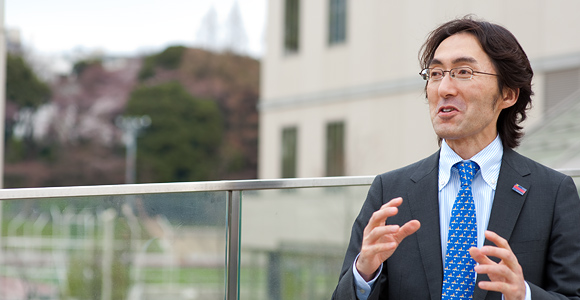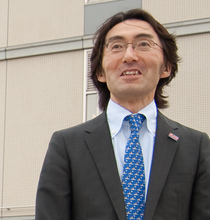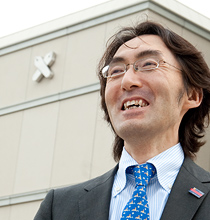Akihiro Sakaedani

SDM provides you with 1) sky-high non-conventional ideas, 2) the resources, such as professional networks, and 3) the thinking tools needed to realize the ideas.
Akihiro Sakaedani
Graduate Student of March 2010
- Degree awarded by SDM: Master of System Design and Management
- Other degrees: BS and master's degree in Physics, Gakushuin University
- Working for: NTT Comware
Mr. Sakaedani developed customer management and call fee calculation systems in the information system division, engaged in technological assessment and standardization of development projects to improve the productivity and product quality, and participated in consulting projects. NTT Comware funded his study at SDM.
Motivation to Learn
 Mr. Sakaedani felt the telecommunication industry had stagnated since he joined NTT approximately 15 years ago. Development languages and tools and other individual elements had improved, but not enough to improve the efficiency in overall development, which would lead to better quality and productivity. The system development field is as chaotic as it was when he started working. Society, on the other hand, is increasingly depending on mission-critical information systems, which are an indispensable part of the social infrastructure.
Mr. Sakaedani felt the telecommunication industry had stagnated since he joined NTT approximately 15 years ago. Development languages and tools and other individual elements had improved, but not enough to improve the efficiency in overall development, which would lead to better quality and productivity. The system development field is as chaotic as it was when he started working. Society, on the other hand, is increasingly depending on mission-critical information systems, which are an indispensable part of the social infrastructure.
He felt there was a massive gap between the kinds of information systems that were being developed in the chaotic field of information systems and the kind required by society today; information systems that can support a high quality and highly productive social infrastructure. At that time, he read on the SDM website that "current large-scale project management is becoming obsolete". Motivated to create new development methodologies for large-scale complex systems, he became eager to study at SDM.
Experience at SDM
Mr. Sakaedani found his two years at SDM to be very rich in experiences; it was hard to name the most memorable event. If he had to choose one, he would say that the first week of each class at SDM had a big impact on him. He found all of the courses he took (intelligence, accounting, project management, system management skills) and the special lectures to be based on practical business cases, not just idealistic theories explained in books, and very useful for a business person. The high quality of these classes assured him that SDM would meet his expectations for the next two years. He thought the crash course by Prof. Rashmi Jain (Stevens Institute of Technology, US), ALPS lectures and exercises by late Prof. Ishii (Stanford University) and Prof. Olivier L. de Weck (MIT) were quite logical and organized. They were different from Japanese thinking process.
As one of the first SDM class members, Mr. Sakaedani gained valuable experience while building the organizations in the new graduate school. His work experience had taught him how important planning is to a project's success and how difficult it is to overcome a bad start. He considers his years at Keio University during its memorable 150th anniversary to be an important part of his life and is proud to have contributed to the establishment of the new graduate school.
Socio-Critical System Laboratory
 Mr. Sakaedani had two instructors in the Socio-Critical System Laboratory. One of them is Prof. Ryuichi Teshima, an active journalist. Prof. Teshima's wide professional network helps to shape his perspective and his ability to conceive new ideas. He helps students to broaden their perspectives too. Prof. Teshima is an excellent communicator who always has a witty comment to make.
Mr. Sakaedani had two instructors in the Socio-Critical System Laboratory. One of them is Prof. Ryuichi Teshima, an active journalist. Prof. Teshima's wide professional network helps to shape his perspective and his ability to conceive new ideas. He helps students to broaden their perspectives too. Prof. Teshima is an excellent communicator who always has a witty comment to make.
Prof. Toshiyuki Yasui, another excellent instructor, is a former government official. His method of organizing and processing ideas has been very useful for Mr. Sakaedani in his current work. He is using Prof. Yasui's method of summarizing ideas, "Super Work Techniques in Kasumigaseki", in his current work.
Students in the Socio-Critical System Laboratory come from various backgrounds, such as pharmaceutical, national defense, and video production, so every student's research topic is intriguing. Even though the topics varied, it was easy to understand the research and observations since everyone used the same thinking tools that they learned at SDM. Students also learn from the approaches that others take.
If Mr. Sakaedani's goal had been simply to research an information system development project from an engineering perspective, he could have done so at NTT. However, he believes it is necessary to seriously learn to think from a completely different perspective to work on large unsolved problems. It is even more necessary when treating problems that have remained unsolved for a long time. Because one can see an information system as not just a technical system, but also a social system based on communication with many people, learning about social systems--including politics and the economy--in the Socio-Critical System Laboratory was very beneficial for a student with an engineering background, such as Mr. Sakaedani.
He is also grateful that these two professors accepted such a student with an engineering background.
What He Gained at SDM
Mr. Sakaedani reflects on his two-year stay in SDM in terms of people, skills, and information.
Firstly, in terms of people, he met many students and professors of various nationalities and ages, and from various industries. Some were recent graduates and others had already retired. Sharing a few years with this diverse group influenced him and promoted his own change.
Secondly, in terms of skills, he acquired various thinking tools. He learned various skills at SDM, not only engineering analytical methods, but also communication skills and idea generation skills. These were so practical that he actually used some of them at work the next day.
Thirdly, in terms of information, SDM provides not only engineering courses but also courses that cover the latest economic and political news; Mr. Sakaedani could dare to learn without considering conventional academic fields. He learned practical viewpoints. From the wide range of courses, he learned to apply a broader perspective and to find a universal rule so that the same thinking process could be applied in designing and implementing the requirements and that the key points were the same whether you were developing a new car or writing new legislation, for example. The problems in various industries can be similar but international laws are tangled like spaghetti. The source code in companies' information systems that have been in place for nearly a decade is getting more difficult to revise and to maintain. Thus, in modern society, people struggle with how well they develop and operate large-scale and complex structures, systems, and schemes. At SDM, he learned about solutions created in various areas.
After Mr. Sakaedani obtained the above knowledge from lectures, he utilized his new thinking tools in his discussions with other students and professors, digested their ideas, and found clues to solve problems in his information system development project.
For his master's thesis, Mr. Sakaedani tried to create a method and a concept to design a project based on the smooth communication of development information within the project. It is a completely new concept in the information system development industry. He hopes to implement the concept and present it at conferences and on other occasions. His ambition for the next decade is to reduce the chaos in information system development, to increase its sophistication, and to organize it as well as a precision machine factory is organized.
Mr. Sakaedani considers this to be his way of contributing to the advancement of society. He will keep a positive attitude about his work.
What is SDM
Mr. Sakaedani believes that SDM provides you with 1) sky-high non-conventional ideas, 2) the resources, such as professional networks, and 3) the thinking tools needed to realize the ideas.

